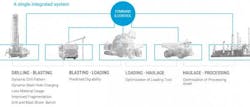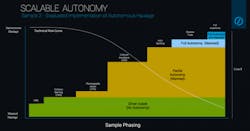Implications for autonomous-vehicle operations in the mining ecosystem are varied. Mining
organizations understand the long-term safety, production and financial benefits of automating vehicles and processes. Many are pursuing such initiatives. However, converting an entire site to full automation is a challenge that proves both structurally daunting and financially prohibitive.
An interoperable command-and-control platform provides a realistic solution by facilitating a scalable approach to automation implementation across an entire mine site. Here, find a deeper look at the benefits of autonomous vehicles in the mining environment, steps to adopting autonomy and the potential results of its successful application.
Industry growth of autonomous mining applications
Machine automation in mining has been a part of industry-wide discussions for years. Rapid advancements in technology have now converted the subject from a utopian concept to a reality. Mine sites throughout the world are researching, designing, implementing and seeing results from autonomous-vehicle programs. Primary benefits include:
- Improved safety
- Reduced damage
- Increased equipment utilization
- Increased productivity
- Reduced cost per ton
- Better asset management
- Optimization of mine plan or mine design
Reports have shown that driverless technology can produce a 15-20 percent increase in output and an eight percent reduction in maintenance.
Using autonomous haul trucks, one global mining organization reported a 13 percent decrease in operating costs and enhancement of utilization rates by 14 percent in 2015 at a mine site in Australia.
While the benefits of driverless vehicles are clear, implementation of autonomous technology also introduces an entirely new set of challenges for pioneers in the mining industry. Among those obstacles are designing an affordable, practical, scalable and sustainable strategy for employing the level of automation that provides the greatest return for each unique site.
Roadblocks for mine sites seeking vehicle automation
Many of today’s mines operate vehicle fleets that are not equipped with autonomous functionality. Additionally, many sites rely on vehicles from disparate manufacturers. The combination of these realities presents significant obstacles for mines seeking a competitive stronghold in the market through automation. Decision-makers are forced to justify autonomous projects on the basis of replacing existing vehicles with new machines, equipped by the OEM for autonomous operation. In such cases, the business case for autonomy often becomes unattractive. To develop a successful automation program and maximize the efficiency of their fleets they are left with vehicle options that are limited to those provided by a single OEM. Using older machines from various manufacturers creates greater complexity and additional challenges for vehicles to communicate efficiently with the mine’s command-and-control platform, fleet-management system and other relevant applications, resulting in lost productivity and significant expenses.
Absorbing the capital expenditures of autonomous programs is another challenge facing forward-thinking mine operations. Even though long-term operating expenditures can be significantly reduced over time with vehicle automation, initial costs can be financially debilitating. The monetary investment and organizational commitment associated with this rapidly advancing technology is inherently high, keeping many mines from exploring opportunities.
Integrated command and control system
An OEM-agnostic, interoperable command-and-control platform provides a practical solution to this industry challenge. Such a solution enables mines to equip mixed fleets of vehicles with autonomous capabilities, regardless of the manufacturer or the vehicle type. A single platform designed to retrofit existing vehicles from all major manufacturers and integrate with multiple systems can serve as an enterprise solution for autonomously operating all mine vehicles within a site, as shown here:
Value of a single interoperable command and control system
Graduated implementation of autonomous mining
Designing an incremental plan for autonomy-adoption provides a practical, low-risk solution to the large capital requirements and daunting tasks associated with a single implementation of a fully autonomous operation. This approach begins with simple applications that expose administrators, operators and staff to smaller degrees of automation and gradually develops to more advanced levels (i.e. tele-op, semi-autonomous, full automation) as the technology’s value is proved and users become more comfortable interacting with driverless vehicles.
An example of this incremental plan of adoption can be further displayed using a simplified, three-step process.
Step One: Driver assist
Many new consumer-vehicle models are equipped with basic driver-assist features. Understanding the public’s natural reluctance to yield complete control of their car to artificial intelligence, automotive manufacturers have built driver-assist technology into their vehicles. Such features include automated parking and lane recognition. By adding these elements, consumers are gradually exposed to autonomy on a minimal, non-invasive and comfortable level.
Similar driver-assist functionality is also available for mining vehicles and can serve as the first affordable, low-risk step to transforming manned operations into fully autonomous fleets.
Autonomous vehicle command-and-control software, such as Mobius from Autonomous Solutions, Inc., serves as integration platforms, connecting fleet management and dispatch information from traditional FMS systems with control and navigation of autonomous vehicles. These vehicle applications may include haulage, drills, or other autonomous applications. The platform serves as a hub that allows for the integration of driver-assist features like collision warning and avoidance systems (CWS/CAS), fatigue monitoring and spotting assist. The CWS module is comprised of an operator warning system that functions independently from the vehicle’s actuation system. Following implementation, the command-and-control platform uses GPS proximity warnings to autonomously operate driver-assist functionalities. In addition, the CWS can also be expanded to include sensor-based detection along with projected-path filters for additional intelligence.
Step Two: Partial autonomy
With an increased level of familiarity with collision warning systems (CWS), vehicle operators become better equipped to incorporate collision avoidance systems (CAS) for greater safety enhancements. While CWS are designed to notify drivers of ensuing danger, CAS are built to physically engage with vehicle actuation, applying the brakes and throttle system of the machine to avoid potential collisions. This type of application also requires hardware installation, where CWS does not.
Partial autonomy may also include functionality such as auto-spotting and additional sensor filters. Auto-spotting helps maintain efficiency and avoid truck/shovel interactions during the loading process by autonomously and precisely spotting trucks to the shovel. When engaged, the auto-spotting module drives the vehicle to a specific point, then back to a separate location predetermined by the operator. Operators can assume control at any time during the spotting cycle by tapping the brake.
Step Three: Full autonomy
Shadow trials serve as a bridge between manned and unmanned operations. Shadowing is conducted by gathering data in the background, while a driver manually operates a vehicle, and running autonomous simulations within the mine circuit. These trials generate “hypothetical driven” data and compares it to “as-driven” data, essentially studying and learning from manual operations.
Shadow trials can minimize disruption of mine production by providing opportunities to evaluate and resolve potential COMMS or false positive obstacle detection events. Administrators can conduct modifications as needed and obtain a high-level assessment of system readiness prior to transitioning from manned to unmanned operations.
Sample phasing of graduated implementation
Potential results of successful application
While several projects using an OEM-agnostic, interoperable command-and-control platform for autonomous-mining vehicles are currently ongoing, many are in the earliest phases of implementation, limiting the extent of existing results. As adoption of this solution increases, and time and technological advancements allow for the completion of incremental phases within graduated implementation plans, further results will become available.
The global mining industry is experiencing exciting advancements in technology that are leading to unprecedented results. While mines understand the value of these technologies, many face barriers to adoption. An interoperable command-and-control platform provides a solution for mines running mixed fleets of older vehicles that are unequipped with autonomous capabilities. This type of platform enables independent vehicles (such as autonomous haulage, drilling, blasting, etc.) to function individually, while operating under a single command-and-control system. As a result, each vehicle can efficiently perform tasks while remaining aware of other vehicles and obstacles within its environment.
In turn, scalable autonomy provides a realistic solution for mines to begin reaping the benefits of driverless vehicles, without the burden of unreasonable capital expenditures and operational risk.
Drew Larsen is director of business development with ASI Mining.





